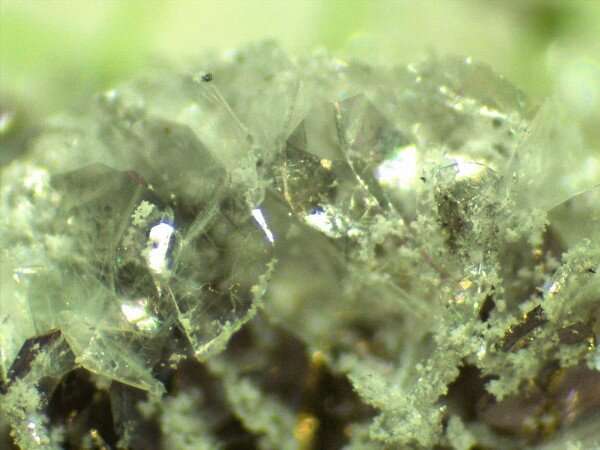A laboratory's "irritating" byproduct now supplies 2D materials research

While making materials samples to pursue their own research goals, scientists at the U.S. Department of Energy's Ames Laboratory discovered that an unwanted byproduct of their experiments was an extremely high-quality and difficult-to-obtain substance sought after by scientists researching layered materials.
With a project name like "Complex States, Emergent Phenomena & Superconductivity in Intermetallic and Metal-like Compounds" one immediately senses that the team of scientists behind that title might have a knack for the weird, unusual, and never-before-seen. The Ames Lab group investigates metallic and semi-metallic compounds that have magnetic, superconducting, or other properties that are designed to probe the fundamental mysteries of how correlated or emergent states can form and, also, might be useful in future tech applications, such as energy creation, transmission and storage as well as quantum computing. But before they can investigate the weird, unusual, and never-before-seen, they have to make it— so the team has decades of expertise in creating those materials as well.
One focus of the group's research is MgB2, a difficult to produce superconducting material. So difficult, in fact, that the tool used to make it is called "The Beast." Lurking in the basement of Ames Laboratory's Spedding Hall, the Beast is a finicky, powerful, and giant high-pressure furnace that super-heats and super-squashes tiny amounts of hard-to-combine ingredients together into new compounds.
Mingyu Xu, a graduate student, has been studying MgB2, and is interested in growing pure and doped, single crystal samples of the material in order to better understand its superconducting properties. He and Raquel Ribeiro, an Associate Professor in the Department of Physics and Astronomy at Iowa State University, work together to load specially designed ceramic cubes (basically volcanic ash) with the tiny crucibles (cups) that will be heated to temperatures as high as 2000 C°, and subject to pressures 30,000 times higher than normal atmospheric pressure.
"We have to be very precise, very particular about how we prepare and load the samples," said Ribeiro. "If we make a mistake, if any piece is out of alignment, it breaks," she said, explaining the unforgiving process of making the material. So demanding is the Beast, Xu and Ribeiro keep track of their mistakes, as a way of documenting how to improve their preparation methods and success rate.
When they succeed, Xu's focus is on the MgB2, literally. His microscope images are focused sharply on the glimmer of pale gold-colored crystals that confirm that the Beast has prepared a successful, high-quality sample. But the images also capture something else— the sought-after MgB2 is surrounded by a nest of translucent, flaky material that is a byproduct of the process, called hexagonal boron nitride, or hBN.
"For years, we tried to minimize this irritating second phase," said Paul Canfield, Ames Lab physicist, Distinguished Professor and the Robert Allen Wright Professor of Physics and Astronomy at Iowa State University, and principal investigator on the project. "Our quest was for MgB2. We didn't want that other stuff, and tried to optimize our process to reduce the amount of it."
In his collaborations with physicists at other institutions, however, he learned that his "irritating second phase" was actually a highly sought-after and difficult-to-obtain insulating material for scientists researching graphene, the 2D layered semimetal that was first discovered in 2010, and is studied for its fascinating and unusual electron transport properties.
"Imagine you discovered the sandwich, and it's easy to get the ham, but bread is hard to come by. White bread is boring by itself, but if you have it you can make your sandwich," said Canfield, "hBN is the bread to make that sandwich." Layers of insulating hBN separate graphene and other novel electronic and magnetic materials to make new heterostructures; new-physics sandwiches with properties that may ultimately replace transistors.
Suddenly, Canfield's group found themselves hBN bakers to other scientist's 2D sandwich making efforts— a scientific side hustle, if you will. Xu and Ribeiro have adjusted their systematics operating the Beast to optimize both the production of MgB2, and its desirable byproduct. By doing so, Ames has evolved into being one of the few sources worldwide of hBN, playing a key role in multiple high-profile publications. Ames Laboratory has supplied hBN to MIT, Rutgers, Princeton, Cornell, Stanford, Lawrence Livermore, and other institutions. The resulting research has been featured in Nature Communications, Nature, and Science.
"It's really gratifying that we have a Department of Energy National Laboratory, not only pursuing its own research goals, but also playing an essential role in enabling key physics discoveries at other laboratories and at other institutions," said Canfield.Scientists shuffle atomic layers like playing cards to make new quantum materials
No comments:
Post a Comment